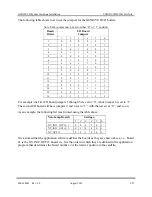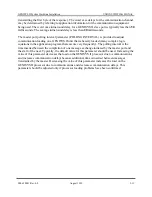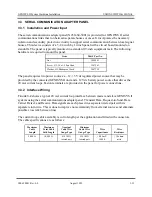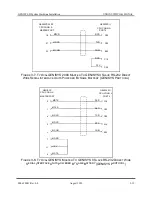
GENISYS II System Hardware Installation
UNION SWITCH & SIGNAL
SM-6900B Rev. 0.0
August 1999
3-5
that the master-end of the circuit does not have to wait for carrier to stabilize before the
transmission of each message, as the outbound office carrier is always on.
Typically, the slave-end of the communication circuit always keys its outbound carrier on and off
whether a half-duplex or full-duplex circuit is used. This is because a GENISYS protocol master
usually communicates with more than one slave, and the slaves would interfere with each other if
they did not turn on their outbound carrier only when responding to the master. However, on a
point-to-point, full-duplex communication circuit (a circuit having only one GENISYS protocol
master and slave), both master- and slave-ends may operate with their carrier strapped
continuously in the ON state. In this case, the GENISYS protocol port RTS output signal is not
connected to the modem RTS (or KEY ON) input. The modem RTS input is permanently
strapped in the active state by applying the appropriate voltage to the modem RTS input or by
configuring the modem to transmit continuously.
The GENISYS protocol requires only that the DCD input signal be connected to the DCD output
of the modem for half-duplex modems. For full-duplex modems, the DCD input of the GENISYS
protocol serial port is either disconnected or strapped in the active state.
In a typical full-duplex modem installation, only TXD, RXD, and COM are connected on the
master-end and RTS, TXD, RXD, and COM are connected on the slave-end. In a half duplex
modem installation, RTS, TXD, RXD, DCD, and COM are connected on both master and slave-
ends of the communication circuit.
When it is available, the CTS signal can be used to shorten the required delay between the
assertion of RTS and the transmission of the first byte of outbound data. This delay is often
called the key-on delay. Typically, when data is to be transmitted via a modem and keying of
carrier is required, RTS is asserted and a delay timer is started by the serial port handler to delay
the transmission of the first byte of data. This delay allows outbound carrier time to stabilize
prior to the beginning of data transmission. This timer is normally set to the worst-case carrier
stabilization time for the modem. The CTS output from a modem is asserted when the outbound
carrier is ACTUALLY stable and ready to transport data. While the use of CTS is optional, it can
improve the efficiency of the communication link by allowing data transmission to begin as soon
as outbound carrier is stable and before the worst-case carrier stabilization time has elapsed.
3.2.3 Connecting to RS-485 Serial Ports (Refer to Figure 3-3)
Serial ports 1 and 2 are the RS-485 serial ports. Port 1 supports TXD and RTS output signals and
RXD, DCD, and CTS input signals. Data clock signals including transmit clock (TXC), which
may be either an input or an output, and receive clock (RXC), which is an input, are present on
port 1 but are not currently supported by the GENISYS II executive. These signals should not be
connected. These signals may be supported in a future release of the GENISYS II executive.
Port 2 supports TXD and RTS output signals, and RXD and DCD input signals.
Each RS-485 port signal is transported by a twisted pair of wires labeled as XXX- and XXX+
(TXD- and TXD+, for example). Outputs labeled with (-) always connect to inputs labeled (-) or
(A). Outputs labeled with (+) always connect to inputs labeled (+) or (B). Differential voltage
Summary of Contents for GENISYS II
Page 4: ......
Page 6: ...GENISYS II System Hardware Installation UNION SWITCH SIGNAL 1 2 August 1999 SM 6900B Rev 0 0 ...
Page 12: ...UNION SWITCH SIGNAL GENISYS II System Hardware Installation 2 ii August 1999 SM 6900B Rev 0 0 ...
Page 38: ...UNION SWITCH SIGNAL GENISYS II System Hardware Installation 2 26 August 1999 SM 6900B Rev 0 0 ...
Page 40: ...UNION SWITCH SIGNAL GENISYS II System Hardware Installation 3 ii August 1999 SM 6900B Rev 0 0 ...
Page 60: ...UNION SWITCH SIGNAL GENISYS II System Hardware Installation 3 20 August 1999 SM 6900B Rev 0 0 ...
Page 62: ...UNION SWITCH SIGNAL GENISYS II System Hardware Installation 4 ii August 1999 SM 6900B Rev 0 0 ...
Page 66: ...UNION SWITCH SIGNAL GENISYS II System Hardware Installation 4 4 August 1999 SM 6900B Rev 0 0 ...
Page 67: ......






























